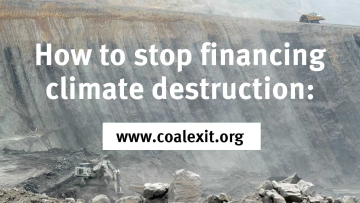
Company – On record
This profile is no longer actively maintained, with the information now possibly out of date
Company – On record
This profile is no longer actively maintained, with the information now possibly out of dateWhy this profile?
KEPCO operates coal power plants and is expanding its coal power generation capacity by 3.2 gigawatts (GW) with the Vung Ang 2 and Java 9 & 10 coal-fired power projects. KEPCO’s plans run counter to the coal phase-out mandated by the Paris Agreement climate goal of limiting global temperature rise to 1.5ºC. KEPCO is a major global coal power developer and has bought equity in and lended to fossil fuel projects across the Middle East, Asia and Africa.
What must happen
Banks must cease finance of KEPCO, on the basis that the company is a major coal developer and expander. Crucially, banks must rule out financing KEPCO's recent spate of bond issuances, which it has issued to bolster its finances made shaky by its loss-making fossil fuel investments.
| Sectors | Coal Electric Power Generation, Coal Mining, Nuclear Electric Power Generation |
| Headquarters |
|
| Ownership |
listed on Korea Exchange & NYSE
As of December 2022, the Korean government holds 18.2% of KEPCO shares and the Korea Development Bank holds 32.9%. KEPCO's shareholder structure can be viewed here. |
| Subsidiaries |
|
| Website | https://home.kepco.co.kr/kepco/EN/main.do |
KEPCO (Korea Electric Power Corporation), founded in 1898, is the largest electric utility in South Korea, responsible for 93% of South Korea's electricity generation. Together with its affiliates and subsidiaries, KEPCO has an installed capacity of 82.5GW, of which 39.5% is coal and 21% is LNG. KEPCO owns or co-owns several power generating operations overseas, including in Mexico, the Philippines, Saudi Arabia and Jordan.
Impact on human rights and communities
A Greenpeace report on health issues attributed to coal use in the Philippines, one of the many countries in which KEPCO is active, describes devastating health impacts of the coal-fired Cebu power complex (also called the Naga power station). KEPCO has a 60% stake in the complex. The report concluded that Cebu was one of three power stations collectively responsible for an estimated 960 premature deaths each year due to stroke, ischemic heart disease and other cardiovascular and respiratory diseases. This number would rise to 2,410 deaths each year if eight more plants in the pipeline at the time of the report were to operate as planned. The report estimated that the total annual emissions of the Cebu power complex include 5,040 tonnes of sulphur dioxide per year, 3,635 tonnes of nitrous oxide, and 401 tonnes of particulate matter.
These figures relate to just one of KEPCO’s major coal projects. Other major KEPCO coal projects are Java 9 & 10 in Indonesia (ten times larger than Cebu by capacity) and Nghi Son and Vung Ang II in Vietnam (10 and 25 times larger, respectively). Java 9 & 10 is expected to cause 4,700 deaths over its lifetime. Further details on the health impacts of these projects is available on their respective BankTrack profiles.
Impact on climate
According to the 2022 Coal Exit List, KEPCO has 36.5GW of installed coal power capacity, accounting for 43% of its total power production. It is thus a major part of the last vestiges of the global coal industry, which must be replaced if humanity is to preserve the climate goals of the Paris Agreement.
Like all coal-fired power stations, KEPCO's coal projects emit sulphur dioxide (SO2), which contributes to acid rain and respiratory illnesses; nitrogen oxides (NOx), which contribute to smog and respiratory illnesses; particulates, which contribute to smog, haze, and respiratory illnesses and lung diseases; carbon dioxide (CO2), which is the primary greenhouse gas produced from fossil fuels (coal, oil, and natural gas); mercury and other heavy metals, which have been linked to both neurological and developmental damage in humans and other animals; and fly ash and bottom ash, which are residues created when coal is burned at power plants.
Furthermore, KEPCO’s Cebu Naga coal plant in the Philippines uses outdated subcritical technology (which is not able to convert water into its supercritical fluid state, which requires significantly less energy to power turbines). Compared to supercritical plants, subcritical coal-fired power stations emit 75% more CO2 and use 67% more water. This means that KEPCO is actively involved in the operation of plants that are not only harmful to people's health, but are also extremely inefficient, increasing their climate impact.
KEPCO's major shareholder is the Korea Development Bank, which holds 32.9% of KEPCO's shares. Between 2014 and 2017, 38 financial institutions provided a total of US $11.34 billion in loans and a total of US $11.63 billion in underwriting services. See KEPCO's financiers below.












